Jenny West is an artist producing drawings as both works on paper and as sculptural installations. Through precise and methodical processes, she builds drawings that are often based on domestic objects and focuses on pattern, geometry and the spatial. Court Spencer went to her home studio to see a new body of work and find out more about her practice.
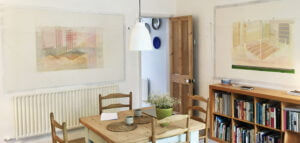
Work in progress
Court: Thank you so much for having me over. It feels so fitting that your work, much of which is based on domestic objects, is created here in a stunning space that is such a beautiful blend of home and studio. Some of the first work I saw of yours referenced kitchen moulds and funnels. Have domestic objects always been an area of interest?
Jenny: I have always been fascinated in the connections between functional objects used in every day life and their employment in art. Emblematic and symbolic utensils and furniture included in Etruscan and Egyptian tombs and domestic interior architecture depicted in Italian Renaissance paintings. The honesty and simplicity of tools and implements, particularly ones which are linked to the preparation of food and the production of drawings, offer a personal autobiographical connection – in the work I make objects often stand in for a biographical content, but are also about form and function.
Court: Your current series of work that surrounds us draws on objects from your home. Can you tell us a little about this current series of work that surrounds us?
Jenny: These two works are part of a series of seven drawings made during the last year. Measurements taken from objects and furniture within my home, such as the kitchen table, the bed and book case form plans for constructions of delicate, skeletal sculptural objects and spaces. I have also referred to Japanese Ukiyo-e woodblock prints and frescoes by Far Angelico. Each drawing is made on paper stretched flat to the wall within the rooms of my house. I develop the work slowly through a process of intuition and exact mathematical measurement and construction, the drawings could be described as being somewhere between a plan for an architectural form and a mapping of time. When I began the series I gave myself a time limit for making each work, which was 7 days, but I have gone far beyond this limitation, and so have broken my own rules!
Court: Much of your work has an ethereal quality to it but particularly with this current series where the layers of drawings are almost suspended over one another. I know in the past you’ve described your work as being in a “perpetual state of becoming.” Is it hard to know when something is finished or is it a very definite feeling that you get?
Jenny: In this series I have found it very difficult to know when to stop, this was one reason why I initially gave myself a time limit of 7 days. The construction of the drawings is exposed and very evident and images evolve like thoughts. However, the drawings are purposefully illusive and unfinished in appearance: I see them as works towards something, visions of objects and spaces which I am unwilling to make actual or real and in a constant state of flux. With these criteria in mind I gradually arrive at a decision to stop, but this relies on moments of contemplation rather than a clear and fixed end point.
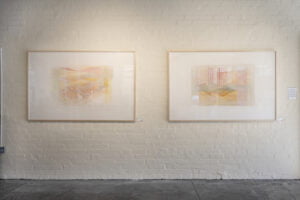
Room to Room 1 & Room to Room 5, at Sunny Bank Mills Gallery
Court: I was thrilled that you agreed to show in the exhibition Definitions of Drawing that I curated with the team at Sunny Bank Mills Gallery. Your two-dimensional works on paper and three-dimensional installations feel like they’re constructed in similar ways, that is, drawn with lines utilising perspective. I know you studied sculpture in Falmouth though would you say that your work is primarily about drawing?
Jenny: Yes, I would say that through drawing I think, it is a process that allows me to travel, it’s immediacy allows for change and revision. I recently listened to a lecture by the artist Amy Sillman and she described drawing as “manual thinking”, which I thought summed up my own approach. I don’t think about the object or what is produced but about a responsive process. This often results in work which appears unfinished or visually slight. When developing three-dimensional objects in space or site specific installations, I develop works, initially, in a very similar way to how I make the drawings on paper.
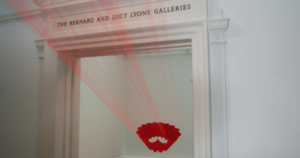
Brioche Mould : Inside Double, site-specific drawing at Leeds City Art Gallery
Court: These works on paper are sizeable, and still have vanishing points and lines that extend beyond the paper and your installations use the space in a room and at times travel through into adjacent rooms. Can you talk a little about space and scale within your work?
Jenny: I have always been fascinated in the relationship between drawing and sculpture, in works which inhabit an in-between state – drawn structures which could be realised as sculpture or architecture yet are liberated from manifestation in a physical form and reside in a hovering state between form and idea. The provisional character of these drawings allows me to envision forms in improbable scales and for impossible conditions. The slightness of line used in the construction of the perspective drawings and also in the spatial, three-dimensional works attempt to amplify the spatial uncertainty.
Court: Speaking of physical liberation, up until last year you had been lecturing at Leeds Arts Uni. How are you finding the freedom and flexibility you have now?
Jenny: I am relishing the freedom I now have.
Court: What sort of support have you found useful within your career to date?
Jenny: The support I’ve received is extensive and varied, from my husband Steve West who was an artist, to my children Liz and Matt who both have successful careers in the arts and crafts, and importantly the colleagues I have worked alongside and students I have taught and worked with.
A three year AHRC research fellowship grant while at Loughborough University was wonderful. One thing leads to another, and the development of a series of works at YSP in 2003 as a result of the fellowship led directly to a government arts collection commission for a site specific work for the British Embassy in Sana’a, Yemen. The support of curators who have offered opportunities for me to explore new ways of working and to take risks and push personal boundaries to writers who have carefully and sensitively interpreted my work. And importantly if not directly the artists, writers, musicians, and academics who have provided a source of stimulus through the works they have produced, both past and present.
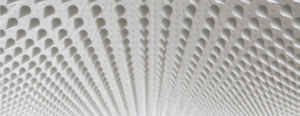
One Thousand Four Hundred and Forty to Zero, site-specific work, British Embassy, Yemen.
Court: That’s really nice to recognise the work of others that has inspired you and I’m sure your work has inspired many.
You’ve had some great shows. When I first moved to Leeds in 2005, there was a piece using iridescent thread in Leeds Art Gallery, another piece at Yorkshire Sculpture Park and I remember images of the commission in Yemen. What has been your career highlight to date?
Jenny: That is a difficult question, I will cite two highlights – the first was having a drawing selected from an open submission for the Hayward annual 1982: British Drawing which was subsequently purchased by the Arts Council for their collection. The second was the three year AHRC funded Research fellowship at Loughborough University which I was awarded in 2000. This provided support for a series of spatial drawing projects culminating in the development of large scale work at Yorkshire Sculpture Park. Both of these opportunities or successes gave me confidence, and although there is a very fine line between success and failure and the resulting consequences, this confidence helped me to progress, take risks and to believe in the value of my work.
Court: And do you have a dream project that you would love to make happen?
Jenny: I have always been interested in the relationship between the work of art and the site where it is made, where the experience of viewing the work is inseparably linked to the specific place. An example of this would be the frescoes of Far Angelico in the Convent of San Marco in Florence, Egyptian tomb paintings and the wall drawings of Richard Wright. And so a dream project would be to develop drawings directly and physically in and upon an architectural space, which were made over a period of time, a period which would allow for the gradual process of change and transition that normally occurs in the private space of the studio. This project would be a subtle and thoughtful response to a space.
Court: You’re currently in the Definitions of Drawing exhibition at Sunny Bank Mills Gallery. Are you working towards any other shows or projects at the moment that we can keep an eye out for?
Jenny: I will be developing new work for an exhibition at Studio 2 Gallery, Todmorden in the summer of 2022.
Court: Ah that’s brilliant, I look forward to seeing it. I’ll keep an eye out on your Instagram and website for the details. Thank you so much for your time. It really is fascinating to hear more about how your work and see it alongside the objects that have inspired the pieces. Thank you and a special thanks for the lovely homemade cake!
Filed under: Art & Photography
Tagged with: art, art studio, column, court Spencer, drawing, interview, Jenny west, Leeds art, Leeds arts university, material art, materials, painting, sculpture, studio visit, Sunny Bank MIlls
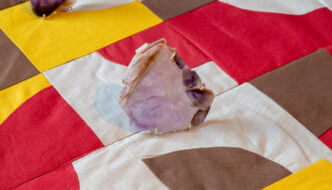
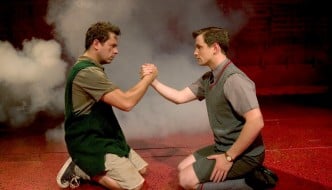
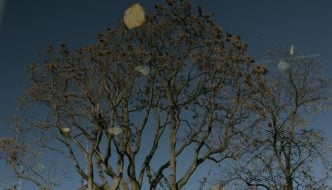
Comments